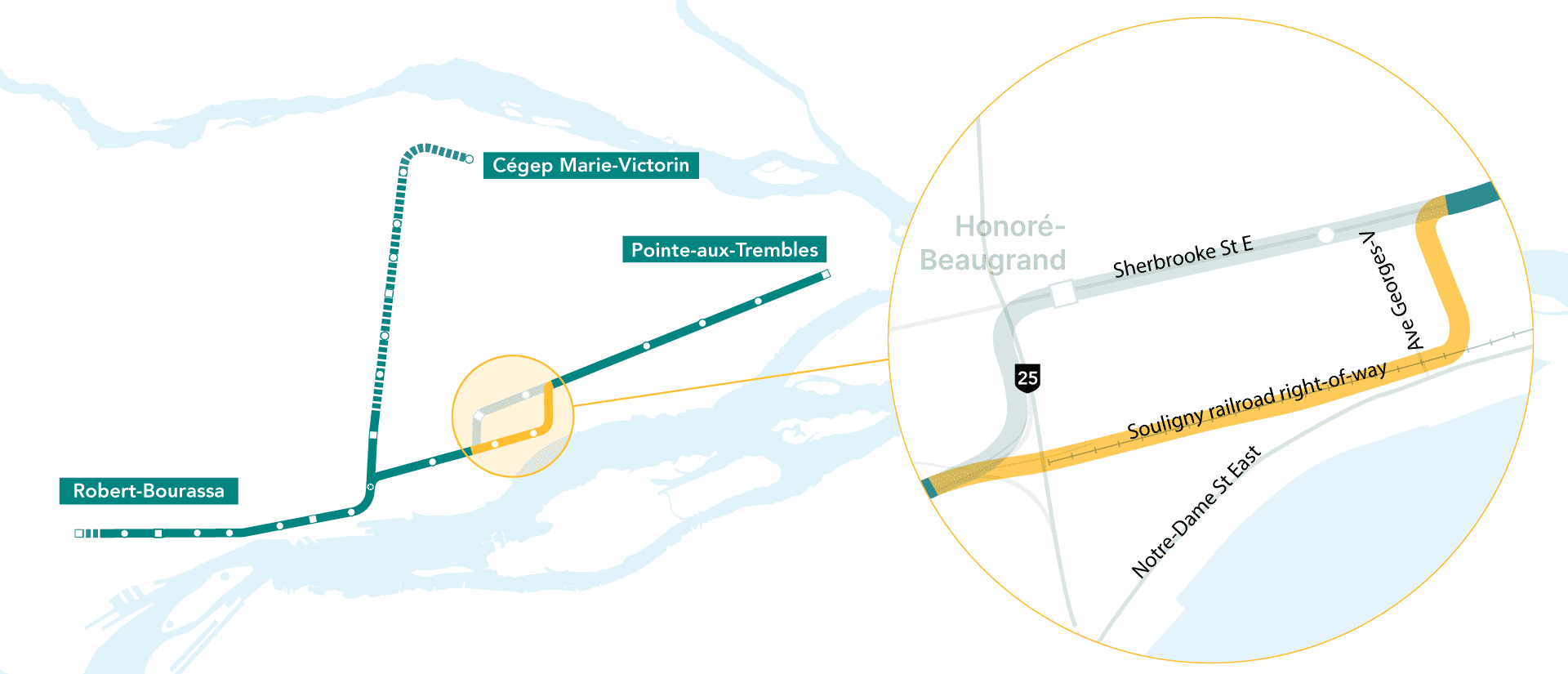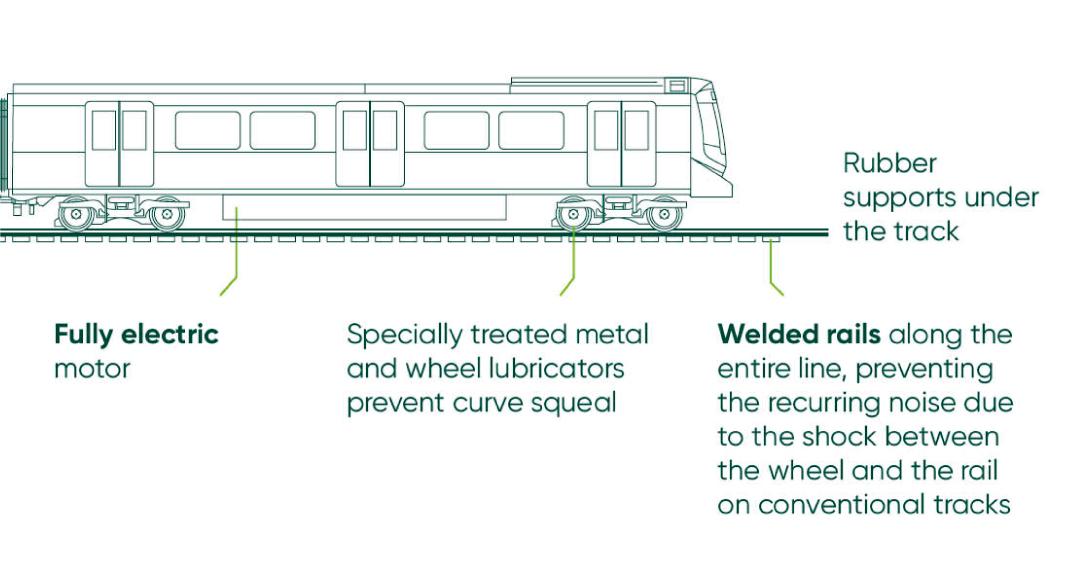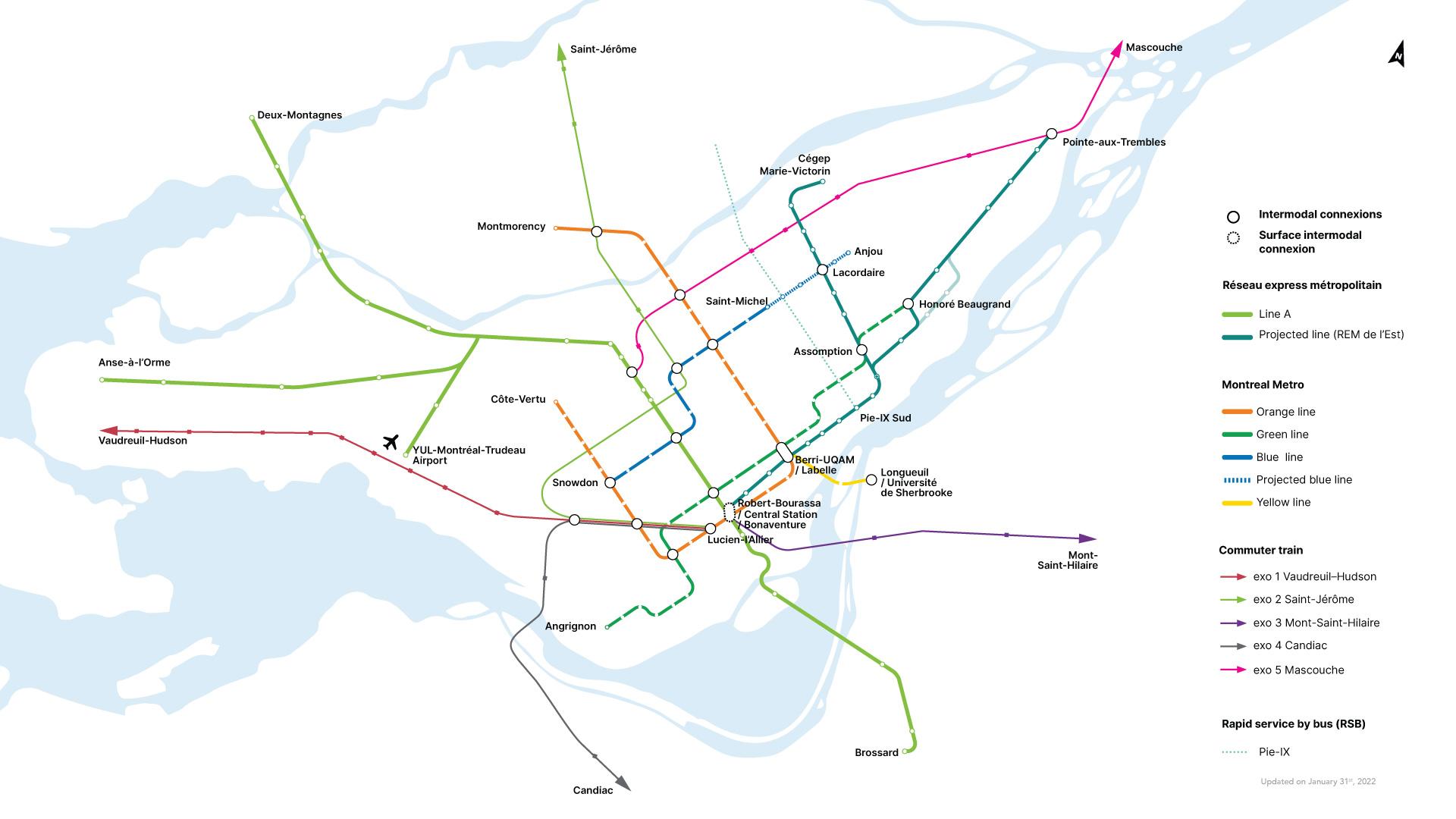Souligny route: answers to your questions
On January 25, CDPQ Infra presented a proposal for a change to the REM de l’Est route via the Souligny railway right-of-way. Here are some answers to questions asked by citizens in the last few days.
1 – Sherbrooke, Souligny... what is the change to the proposed route?
During public consultations conducted in 2021, many stakeholders and citizens expressed the wish to avoid having the REM de l’Est run in the commercial corridor of Sherbrooke Street East. The CDPQ Infra teams set out to find solutions.
The new proposal: a 4.5 km portion of the REM de l’Est route would be moved. Instead of veering north at the A25 and reaching Sherbrooke Street East quickly, the route would use the Souligny railway right-of-way for about 2.5 km and then move north to run on Sherbrooke East at Joseph-Versailles Boulevard.

Zoom in to the proposed route option since January 25
2 – Underground, elevated, on the surface? How will the proposed new route be integrated?
Because the REM de l’Est is a light rail system running at very high frequency on 100% dedicated tracks, our design teams’ preferred choice is an elevated structure, as this would allow the north-south crossings of the railway right-of-way to be kept. This means there would be no impact on road and pedestrian traffic.
However, analyses are ongoing and CDPQ Infra is fully focused on the engineering study phase. Our teams will also present the surface option during public meetings. Having part of the section running on the ground could be considered if desired by citizens.
3 – What about the connection to the Honoré-Beaugrand station on the green métro line?
The Sherbrooke Street East route provides two connections to the green line, one at Honoré-Beaugrand station and one at L’Assomption station.
With the proposed change using the Souligny right-of-way, intermodality is provided by a connection to the L’Assomption green line station, as well as other connections shown on the map.
What would be the impacts of the Souligny option on the network?
- A very small decrease in the use of the REM de l’Est: according to our studies, the change of route would lead to a non-significant loss of ridership – of around 2.5% – compared to the initially proposed route, mainly in the eastern branch of the REM de l’Est, between Pointe-Aux-Trembles and Honoré-Beaugrand.
- Little impact on the Montreal métro: total ridership of the green line would be almost the same whether the Sherbrooke or Souligny route option were chosen. However, studies show that the Souligny route would make a difference during the morning peak period (between approximately 6:00 a.m. and 9:00 a.m.), with approximately 1,000 fewer riders boarding at Honoré-Beaugrand station to travel westbound (towards Angrignon).
- Opportunity to serve a new clientele: the southern part of Tétreaultville, along the Souligny right-of-way, is more residential than Sherbrooke Street. Passage on this right-of-way would benefit a population that currently has no access to public transit.
4 - What impacts can we expect from the construction of the REM de l’Est in Tétreaultville?
We have to comply with very strict rules regarding the impacts of noise, vibration and dust. These rules are governed by an environmental decree issued by the Québec government.
Many citizens are concerned about the impact of the construction of the REM de l’Est on the foundations of their properties in the Tétreaultville sector because of the composition of the soil in this area. Champlain clay is very common in Montréal and does not prevent the construction of infrastructure. Our teams will conduct geotechnical studies to confirm technical details, such as the depth of the clay. They will propose construction methods that are suited to the area, to limit impacts.
5 – What will be the visual and noise impacts on local residents once the REM de l’Est is in service?

Image from the REM project. The technology used by the REM de l’Est will also be an automated, 100% electric light rail system.
When the REM de l’Est is in service, noise could come from two main sources: passing trains (caused by machinery and/or wheel-rail interaction) and stationary sources (station systems, activities near stations, etc.).
To assess the impact of noise, two main inputs are considered:
- Consideration of current ambient noise, road traffic, topography, proximity of residential areas, etc.
- Addition of noise from the REM de l’Est, taking into consideration frequency and speed, structure elevation, route curves, etc.
Sound modelling will be carried out to assess the impact of the REM de l’Est. Two possible scenarios will emerge from the modelling: an imperceptible impact, because the REM de l’Est would blend into the ambient noise, or a significant impact. If the impact is considered significant, mitigation measures will be put in place.
The visual impact will depend on the choice of route. Our design teams are currently working on the proposed architecture and integration of the REM de l’Est. The overall objective is to ensure that infrastructure fits harmoniously into neighbourhoods, thereby limiting visual impacts. More details to come in the next few weeks.
6 – How many stations will there be, and where will they be located on the Souligny route?
Two stations would be planned along the Souligny route, as was planned for Sherbrooke. Their exact location is still under study and will be determined based on available land, areas to be served and ridership.
7 – How can we express our thoughts about this new proposal?
Speak with our experts and share your views on the REM de l’Est’s integration into the Mercier-Est sector at public meetings.
- Tuesday, February 15, from 8:00 to 9:30 a.m.
- Thursday, February 17, from 6:00 to 7:30 p.m.
Unable to attend? A recording of the meeting and associated documentation will be available a few days after the meeting. A virtual consultation platform will be available in the coming weeks to let you to express your views specifically on this route change.


